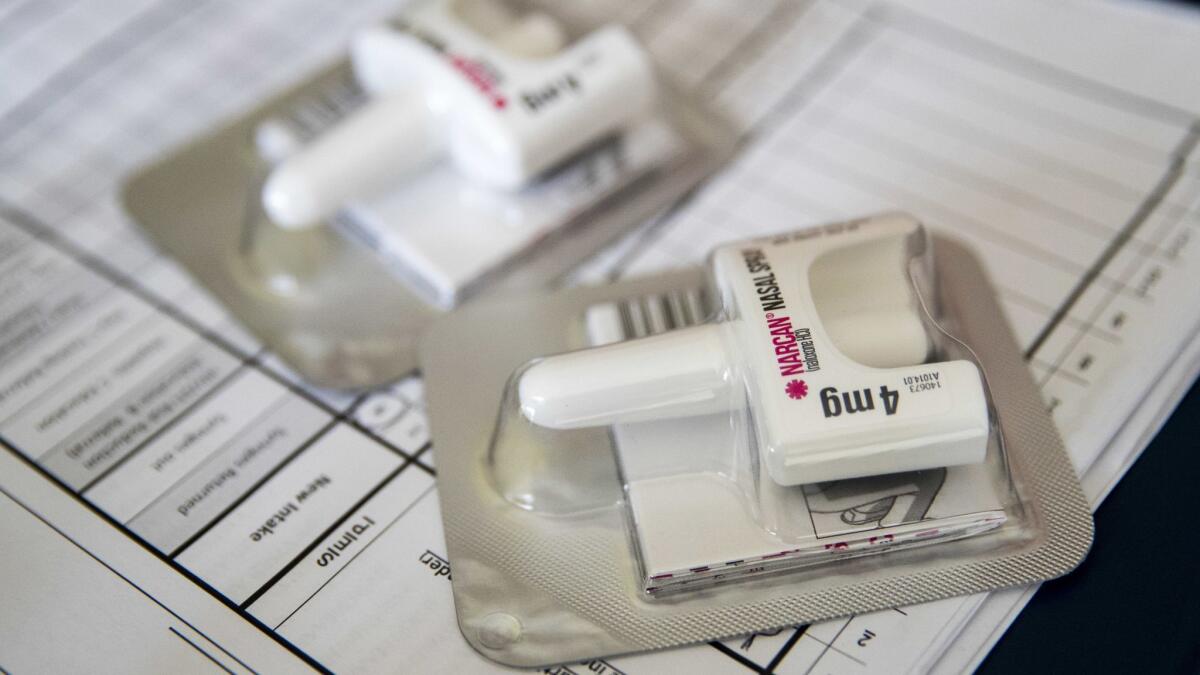The drug that saved the people who overdosed in Chico

- Share via
Chico police officers knew they had only minutes to act when they pulled up to the house where someone had called 911.
Limp bodies were splayed inside, in the backyard and in the garage. Some people looked pale and felt cold to the touch; others had stopped breathing. One person’s skin had turned purplish.
Officers suspected a mass overdose of heroin or some other opioid. So they reached inside their squad cars’ glove compartments for naloxone, a medicine that can reverse opioid overdoses.
As the officers administered the antidote, some of those who had overdosed seemed to jolt back to life. They gasped for air or their breathing quickened. Their bodies grew warmer.
One person was declared dead at the scene. But a dozen others who overdosed on Jan. 12 survived, in part because they were quickly treated with naloxone, officials say.
“Without that, I’m convinced that we would have had certainly four or five, if not more, additional fatalities,” Chico Police Chief Michael O’Brien said. “There’s no doubt it saved lives.”
As the opioid epidemic continues to claim lives in California, police officers and first responders in the state are increasingly stocking naloxone in their patrol cars. More than 50 law enforcement agencies have requested the medicine from the state Health Department since the agency began distributing it at no-cost in October.
The spread of naloxone is part of a push to equip as many people as possible with the medicine, in case they come across someone who has overdosed, though some law enforcement agencies remain hesitant.
When the call came in around 9 a.m. that Saturday morning, eight officers responded — all those on duty in the town 90 miles north of Sacramento.
When they arrived, some people were performing CPR on unconscious victims. Police found someone passed out who seemed to have just come out of the shower. One person lay unconscious in a hammock in the backyard.
A group of friends had been at a party and returned to the house early in the morning and began doing drugs, O’Brien said. Officials believe the young adults overdosed almost immediately, suggesting the drugs they took contained fentanyl, an opioid that is 100 times more powerful than morphine.
A very small amount of fentanyl can be fatal, and often users don’t know their drugs have been laced with grains of the white powder.
Chico police began carrying naloxone in their squad cars last year, in part because they were worried about the arrival of fentanyl, O’Brien said. Deaths from fentanyl in California nearly tripled between 2015 and 2017, the latest year for which data is available.
“We knew fentanyl had been moving west,” O’Brien said. “Now that we’ve had this mass casualty incident ... that should concern us all.”
Officials have not said which drug the fentanyl had been mixed with, but fentanyl has increasingly been found in non-opioids such as methamphetamine and MDMA. Last year, three men in Los Angeles overdosed from cocaine laced with fentanyl. In 2016, 58 people overdosed and 12 died in Sacramento from counterfeit painkillers tainted with fentanyl.
On Jan. 12, Chico officers administered naloxone — often referred to by its brand name Narcan — in the form of a nasal spray, similar to an allergy medicine.
Aris Turner, a 34-year-old Chico resident, was declared dead. Twelve others were taken to the hospital; four required respirators to breathe, but all survived.
The Chico officers who used their naloxone supply that morning restocked it later that afternoon.
The California Health Department allotted $19.7 million in October to provide free naloxone to churches, schools, police officers and other organizations.
The single largest order among the 56 law enforcement agencies that have requested the medicines was from the Los Angeles Police Department. The agency began distributing the kits to officers in December, LAPD spokesman Josh Rubenstein said.
Yet many police departments have not employed naloxone. They point out that ambulances often respond to 911 calls before them, or that they are worried about liability from administering the drug. Officers may also be hesitant to embrace naloxone because of stigma around drug users, said UCSD professor Peter Davidson, who studies addiction and treatments.
But Davidson pointed out that there is almost no risk associated with naloxone; administering it to someone who is not having an overdose has no effect. A California law also protects officers from any liability if they administer the antidote and it does cause problems, he said.
He anticipates that within the next five to 10 years, carrying naloxone will become standard among officers, especially if death tolls from opioids continue to mount.
“It’s great for law enforcement to have it, because when they are the first people there, that’s someone who’s not dead,” Davidson said.
Cassie Miracle, founding member of the Northern Valley Harm Reduction Coalition in Chico, said she believes a large swath of people should have naloxone on them, not just officers. Many advocates agree.
“Often times we only think of our first responders like police and paramedics, and not drug users and the people around them — they truly are there first,” Miracle said. “Those minutes count.”
She has struggled to attract people to naloxone trainings in Chico over the past year, though the recent tragedy might have changed that, she said.
On Thursday, Miracle held a naloxone training for the Butte County Sheriff’s Department, she said. Another training for community members hosted at a bookstore later that day drew 30 people, her organization’s highest ever turnout, she said.
“It’s unfortunate that it took such a big event for us to get active and actually get Narcan into the hands of folks, but we will happily do that,” Miracle said.
Twitter: @skarlamangla
More to Read
Sign up for Essential California
The most important California stories and recommendations in your inbox every morning.
You may occasionally receive promotional content from the Los Angeles Times.










